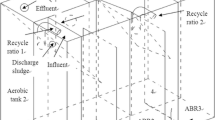Abstract
The microbial community structures of a conventional activated sludge and MBR systems treating the municipal wastewater were studied using Fluorescent in-situ Hybridization (FISH) analysis to identify differences in both systems. The oligonucleotide probes specific for overall bacteria, including α-, β-, and γ-subclasses of Proteobacteria, ammonia-oxidizing bacteria (Nitrosomonas), and nitrite-oxidizing bacteria (Nitrobacter) were used to compare the microbial community structure of both systems. A trend of less hybridization with bacteria-specific probe EUB338 was observed in MBR systems operated under aerobic condition, compared to conventional activated sludge system. The less hybridization trend with the probes could be associated with low ribosomal RNA (rRNA) content in the biomass, which suggests that the biomass in the MBR system was not in a physiological state characteristic for growth due to low substrate per unit biomass
Similar content being viewed by others
References
Chiemchaisri, C. and K. Yamamoto (1994) Performance of membrane separation bioreactor at various temperatures for domestic wastewater treatment. J. Membrane Sci. 87: 119–129.
Witzig, R., W. Manz, S. Rosenberger, U. Krüger, M. Kraume, and U. Szewzyk (2002) Microbiological aspects of a bioreactor with submerged membranes for aerobic treatment of municipal wastewater. Water Res. 36: 394–402.
Xing, C. H., E. Tardieu, Y. Qian, and X. H. Wen (2000) Ultrafiltration membrane bioreactor for urban wastewater reclamation. J. Membrane Sci. 177: 73–82.
Amann, R. I., W. Ludwig, and K. H. Schleifer (1995) Phylogenetic identification and in situ detection of individual microbial cells without cultivation. Microbiol. Rev. 59: 143–169.
Kämpfer P., C. Müller, M. Mau, A. Neef, G. Auling, H. J. Busse, A. M. Osborn, and A. Stolz (1999) Description of Pseudaminobacter gen. nov. with two new species, Pseudaminobacter salicylatoxidans sp. nov. and Pseudaminobacter defluvii sp. nov. Int. J. Syst. Bacteriol. 49: 887–897.
Wilderer, P. A., P. Arnz, and E. Arnold (2000) Application of biofilms and biofilm support materials as a temporary sink and source. Water Air Soil Pollut. 123: 147–158.
APHA, AWWA, WEF (1992) Standard methods for the examination of water and wastewater. APHA, Washington, USA.
Manz, W., U. Szewzyk, P. Eriksson, R. Amann, and K. H. Schleifer (1992) Phylogenetic oligooxynucleotide probes for the major subclasses of Proteobacteria: problems and solutions. Syst. Appl. Microbiol. 15: 593–600.
Amann, R. I., L. Krumholz, and D. A. Stahl (1990) Fluorescent-oligonucleotide probing of whole cells for determinative, phylogenetic, and environmental studies in microbiology. J. Bacteriol. 172: 762–770.
Mobarry, B. K., M. Wagner, V. Urbain, B. E. Ritmann, and D. A. Stahl (1996) Phylogenetic probes for analyzing abundance and spatial organization of nitrifying bacteria. Appl. Environ. Microbiol. 62: 2156–2162.
Baek, S. H. and K. R. Pagilla (2008) Simultaneous nitrification and denitrification of municipal wastewater in aerobic membrane bioreactors. Water Env. Res. 80: 109–117.
Daims, H., A. Bruhl, R. Amann, K. H. Schlerfer, and M. Wagner (1999) The domain-specific probe EUB338 is insufficient for the detection of all Bacteria: development and evaluation of a more comprehensive probe set. Syst. Appl. Microbiol. 22: 434–444.
Kawaharasaki, M., H. Tanaka, T. Kanagawa, and K. Nakamura (1999) In situ identification of polyphosphate-accumulating bacteria in activated sludge by dual staining with rRNA-targeted oligonucleotide probes and 4′,6-diamidino-2-phenylindol (DAPI) at a polyphosphate-probing concentration. Water Res. 33: 257–265.
Lemmer, H., A. Zaglauer, A. Neef, H. Meier, and R. Amann (1997) Denitrification in a methanol-fed fixedbed reactor. Part 2: composition and ecology of the bacterial community in the biofilm. Water Res. 31: 1903–1908.
de los Reyes, F. L. and L. Raskin (2002) Role of filamentous microorganisms in activated sludge foaming: relationship of mycolata levels to foaming initiation and stability. Water Res. 36: 445–459.
Park, S., J. Park, I. Byun, T. Park, and T. Lee (2008) Autotrophic denitrification and inhibitory effect caused by the injection of spent sulfidic caustic in a modified ludzack-ettinger process. Biotechnol. Bioprocess Eng. 13: 697–704.
Byun, I. G., J. J. Park, S. R. Park, T. H. Lee, and T. J. Park (2008) Characterization of microbial community and kinetics for spent sulfidic caustic applied autotrophic denitrification. Biotechnol. Bioprocess Eng. 13: 96–101.
Author information
Authors and Affiliations
Corresponding author
Rights and permissions
About this article
Cite this article
Baek, S.H., Pagilla, K. Microbial community structures in conventional activated sludge system and membrane bioreactor (MBR). Biotechnol Bioproc E 14, 848–853 (2009). https://doi.org/10.1007/s12257-008-0303-1
Received:
Accepted:
Published:
Issue Date:
DOI: https://doi.org/10.1007/s12257-008-0303-1




